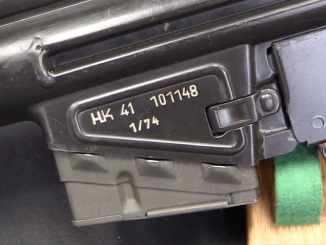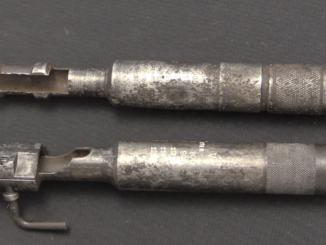These two line throwing conversion are being sold by Morphys on October 31, 2018 (first one and second one)
These two Gewehr 98 rifles were converted by the Mauser factory to be used as naval line-throwing rifles. The exact nature of the line and lead projectiles is not clear, but they are clearly original military conversions and came form the Geoffrey Sturgess collection. Entirely new stocks were made for these guns, with a substantially increased length of pull to mitigate the harsh recoil of line throwing. The magazines were blocked with wooden plugs, allowing only one short (blank) round to be held, but allowing that round to be depressed enough to close the rifle’s bolt over it and keep the chamber empty. The barrels were replaced with launch tubes, on 10 inches long with a 2 inch bore and the other 10.5 inches long with a 1.75 inch bore.




“Gewehr 98 rifles were converted”
Regarding special purpose conversion of that rifle, there existed conversion deployed by Luftwaffe as aid during training of M. G. 15. gunners, see photos:
http://www.vhu.cz/exhibit/nemecka-vycvikova-puska-palubnich-strelcu/
Perhaps the 687 gun was a prototype and they decided they needed a larger projectile and vents to bleed off excess gas, hence the 689 version.
https://www.smallarmsreview.com/display.article.cfm?idarticles=2045 mentions these at paragraph 5 or 6. Reckons they are grenade launchers but they do not fit any then current german grenades, so unlikely. Does explain the painted on numbers, though.
I would conjecture that since the guns were only two digits off in serial number, AND they were all matching, AND the serial number was only three digits in length, that they were not conversions of existing complete rifles, but were built from the ground up as line throwers using Gewehr 98 parts, then serialized after assembly. The double stamped “8” on serial 687’s floor plate indicates that the guns were hand serialized, adding to this theory. If that is true, then it isn’t all that surprising that they are numbers matching guns. Had someone grabbed some random Gewehr 98s off the 1914 production line, the serial numbers would be significantly higher than sub-1000, given the Gewehr 98 was in production since, well, 1898.
Also, according to the Morphy catalog description, all of the major receiver parts are in the white, which would further indicate that the guns were built from ‘parts bin’ receivers prior to the bluing and serializing process, and that they may have been built to test different methods of line throwing, which would explain the two different types of barrels on guns just 2 serial numbers off, and explain why the parts weren’t blued. (Factory experimental guns are often left in the white.) If my wild conjecture is true, then that may also explain why the white painted rack numbers were also just two digits off. They were put on by the testing authority.
Pity that Dr. Geoffrey Sturgess didn’t document the guns more completely.
I think you make a good case. I do wonder why tools intended for Naval use didn’t get some kind of rust protection?
“Mine throwers” NOT “Line throwers” ha ha ha talk about lost in translation!
Source “The former weapons collection of Mauser in Cologne-Ehrenfeld included some odd “Katapultiergewehre für Handgranaten” (Catapult-rifles for hand grenades).” https://www.smallarmsreview.com/display.article.cfm?idarticles=2045
The Mauser Collection Card:
https://www.smallarmsreview.com/images/articles/art_001543/006.jpg
Image Translation:
Group A Group name Army rifles Europe Running time Group No 196
Designation: Hand grenade catapulting gun around 1915 Fabrik-No 689 a.d. usual places
Description of the Weapon:
(Photo shows the experimental rifle A196/serial#689 with the holes cut in barrel.)
Army unit with self-tightening cylinder lock system Mauser, model 98 (A158)
for firing a central fire cartridge for the catapult.
The cartridge corresponds to the rifle sleeve 98 (also read A 191 and A 192)
Manufacturer: of the original rifle Waffenfabrik Mauser, Oberndorf / Neckar
the catapult device and the shaft ver. Mauser Waffenfabrik, Köln-Ehrf.
==============================================================================
In the Original German:
Gruppe A Gruppenbezeichnung Armeegewehre Europa Lfd. Gruppen-No 196
Bezeichnung: Katapultiergewehr für Handgranaten um 1915 Fabrik-No 689 a.d. üblichen Stellen
Beschreibung der Waffe:
Armeegerät mit selbstspannendem Cylinderverschluss System Mauser, Modell 98 (A158)
zum Verschiessen einer Zentralfeuertreibpatrone für das Katapult.
Die Patrone entspricht der Gewehrhülse 98 (lies auch A 191 und A 192)
Hersteller: des ursprünglichen Gewehres Waffenfabrik Mauser, Oberndorf/Neckar
der Katapulteinrichtung und des Schaftes wahrsch. Mauser Waffenfabrik, Köln-Ehrf.
““Mine throwers” NOT “Line throwers” ha ha ha talk about lost in translation!”
My first though after seeing our today weapon was:
http://www.imfdb.org/wiki/Star_Wars:_The_Original_Trilogy#Ion_Blaster_.28Cut-down_Lee-Enfield_No.1_MkIII.29
so it is already closer than I though after reading description.
Using a rifle action for a grenade launcher wasn’t totally insane as the concept was repeated several times elsewhere. Italy had the Carcano carbine with a side-mounted rifle-grenade launcher (which itself had a receiver unit for the rifle’s bolt) and there is at least ONE questionable Sturmkampfgewehr break-action 30mm grenade launcher using a Kar98K as the launching action (the barrel’s been replaced with a smoothbore tube). The latter has functioning sights and just looks downright intimidating, though I wonder if the bolt had to be pulled open before the breech itself could swing open. Can anyone help?
“Can anyone help?”
I am not sure what are you looking for, but converting rifle into grenade launcher appeared a lot of times since Great War, for example there was British grenade launcher prototype crafted with usage of Martini-Henry rifle, see photos:
https://www.thefirearmblog.com/blog/2013/08/12/reallife-steampunk-martini-henry-grenade-launcher/
Italians also created 60mm Lanciabombe which was supposed to be AT weapon:
http://www.tanks-encyclopedia.com/ww2-italy-anti-tank-weapons-60mm-lanciabombe/
and which occupies peculiar place in fire-arms history as when it is loaded it contains 1 shell and multiple propulsive loads (with always 1 one being use to launch 1 shell)
The 60mm Lanciabombe is a very interesting design. It was clearly inspired by the 45mm Brixia mortar, which was a fairly unique take on the light infantry support weapon.
Regarding Brixia Modello 35, another Tank Encyclopedia page might be relevant:
http://www.tanks-encyclopedia.com/ww2/Italy/ansaldo-miasmoras-1935
see 1924 patent drawing. Apparently initial idea was for hand-cranked weapon having 2 separate magazines – 1 for propulsive loads and 1 for shell. Basing on drawing it look there would be still quantity mismatch of both (still fully loaded weapon would contain more propulsive loads than shells).
Grenade launchers built from modified rifle or more exactly musket actions are an old story with European armies, notably with “Grenadier” regiments;
https://s3-eu-west-1.amazonaws.com/lot-images.atgmedia.com/SR/10050/2869404/1794-20131129202033_original.jpg
https://i.pinimg.com/originals/1e/ce/56/1ece5624da0e40c4060e392b0ea1de33.jpg
Note that the lock of the second one, built from a Brown Bess, has the GR indicating that the lock, at least, was Royal government property.
Some operated on a slightly different principle;
https://i.imgur.com/P6Oknrw.jpg
A “tap” opened and closed the fire port from the grenade bucket to the lock, allowing the weapon to be used as a standard musket. A forerunner of the Carcano with its side-mounted launcher, and/or M16/M203 combination, in a way.
The most likely explanation for these two is that they were prototypes intended for trench warfare. At the time (about 1915) the trench lines in Flanders were well established, and as Ian Hogg points out in Grenades and Mortars, the distance between the lines across No Man’s Land was greater than the distance a man could throw a grenade for very obvious reasons.
An assortment of “grenade throwers” were experimented with, the result being the “light” mortars like the British 3-inch Stokes, as opposed to the heavy German Minenwerfers, which were essentially short-range medium-bore howitizers;
https://en.wikipedia.org/wiki/Minenwerfer
But something a bit more mobile was obviously desirable for trench raids and such, not to mention the fact that Minenwerfers weren’t mobile at all and often attracted fire from full-grown howitzers. A British 9.2 HE round is not a comfortable thing to have arrive while you’re loading your 25cm Minenwerfer.
So in the context, these devices, basically reversions to the concepts of the Grenadiers of the late 18th and early 19th Centuries, would seem to make pretty good sense.
The next thing is to identify the grenades intended to be fired from them. If they are respectively 5 cm (2 inch) and 4.5 cm (1.75 inch) bore, then the most likely type would be one of the “egg” type grenades, possibly attached to a wooden “stick” to go down the tube. An arrangement similar to the Krupp “trench howitzer” and its British counterpart, the 2-inch medium mortar, known to Tommies as the “Toffee Apple” or “Plum Pudding” mortar;
https://en.wikipedia.org/wiki/2-inch_medium_mortar
Incidentally, the standard German “Schiessbecher” rifle-mounted grenade launcher of WW2 operated on very much this exact principle, albeit with a rifled launcher cup and rotating bands on the grenade to improve accuracy. The original launcher bore-sized grenades had insufficient HE loads to generate a satisfactory “bang” at the receiving end, so they were succeeded by larger-diameter grenades with a launcher bore-sized “tail boom”;
https://en.wikipedia.org/wiki/Schiessbecher
It’s thus entirely possible that these two gadgets might not even be WW1 era. They might have been made up by Mauser or whoever in the early 1930s using parts on hand as part of the experimental path that led to the Schiessbecher.
cheers
eon
The Germans did have the 75.8mm light Minenwerfers, which while much heavier than the Stokes mortar, could be hauled around by manpower alone. The later “new type” could also fire at low angles when preferred. In fact the “7.58cm leichter Minenwerfer n.A.” was a direct predecessor of the WW2 75mm light infantry gun (7,5 cm le.IG 18), which was also initially called a “Minenwerfer”.
“Minenwerfer”
Germans at least have high-angle “mine” lobber, on the other hand France lacked equivalent of that weapon and deployed Mortier de 15 cm Mle 1838 ‘Crapouillot’: http://www.passioncompassion1418.com/Canons/Eng_AfficheCanonGET.php?IdCanonAffiche=420
Yes, despite Great War might be placed inside ERA OF STEEL in history of artillery time-line, they used weapons which do not fit for current era (barrel of this weapon is NOT made from steel)
“It’s thus entirely possible that these two gadgets might not even be WW1 era.”
One other thing also suggest that: they used their default rifle to create this weapon AND in process it can not be further used as regular rifle. If they would want such type of weapons, I would except usage of older pattern rifles, for example Mauser Modell 1871
The fact that they aren’t finished, i.e. still “in the white”, indicates they are just “toolroom” examples, ones put together from parts to take out to the range just to see if the idea works. This would also explain the painted-on numbers; company inventory numbers instead of Army ones.
Most likely they found out that when fired, these things kicked like mules. Therefore going back to the rifle-muzzle mounted grenade launcher (Schiessbecher)and later the fully-dedicated Kampfpistole grenade launcher would have been the sensible course.
As the old saying goes, “Experiments should be repeatable- they should all fail in the same way.”
cheers
eon
The Austrian 8cm (actually 76.5mm) M.5 field gun also had a barrel and breech made out of autofretted “steel-bronze”. Otherwise the gun was a modern design. The reason for this was apparently that Austro-Hungarian steel industry could not produce enough high quality steel for gun barrels at the time of the design.
Different users, different projectiles? If they were numbered sequentially, they might represent two batches…say for the Turks from 688 onward?
The original markings being scrubbed would suggest against the idea of their being made ‘from scratch.’
Not having samples of the line reels or projectiles is disappointing. Plain weights, or perhaps some grapnel that may, or may not, have had folding prongs.
Having made a serious study of line throwing guns, I am certain that the two auction guns are NOT for line throwing use, and that they are correctly identified in the Small Arms Review article and the Mauser collection inventory card as grenade or mine throwing guns. The bore sizes and strength of the “barrels” are roughly suitable for Viven Bessier size rifle grenades, but perhaps with solid bases (similar to the Mills bomb launched from cup type launchers) instead of the VB system using a ball cartridge passing through a hole in the axis of the grenade.
Shoulder fired line throwing guns were in widespread use beginning around 1899, cheaply adapted from obsolete single shot arms with rod type projectiles about .45-.50 caliber eliminating any need to waste time or money on a complex specially made line throwing gun like the two in the auction.
The later line throwing guns with “barrels” around 2″ bore were for use with “Schermuly” type rockets which fit down into the bore. The rocket base was aligned so that a blank cartridge would ignite the rocket motor and simultaneously the expanding gas form the blank would provide an initial impulse to start the rocket on its way. The barrels were thin, mostly to guide the rocket, not subject to extreme pressures from the cartridge, and with very little felt recoil, so even a child could use them. Totally the opposite of the massive barrels and extended stocks of the auction guns. In WW2 U-boats used the Sander Leinendecker line throwing pistols which were even smaller and lighter than most of the Schermuly rocket pistol apparatus. On the rocket type line throwing guns there was a pair of metal rods extending back from the nose on the OUTSIDE of the barrel, with a swivel bracket (like a tiny bucket handle) for attaching the line- a lightweight cord (around 3/16″ diameter or less).
The two auction guns are really neat and a prize for rifle grenade collectors, but NOT LINE THROWING GUNS.
Ar they not mentioned in “Signalpistolen der Welt – Enzyklopädie der Signalpistolen und Leinenwerfer, Band 1” by Dr. Bruno Baumgarten?